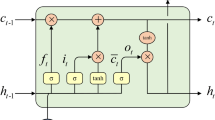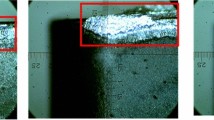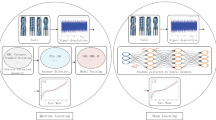Abstract
During the hot rolling process, the work rolls suffer severe wear, resulting in a relatively short lifespan. Severe roll wear can adversely affect the strip shape while introducing roll wear into the crown calculation model can enhance the model accuracy. Therefore, it is crucial to quantify roll wear during the rolling process. Roll wear is a nonlinear time series and the accuracy of the existing work roll wear mechanistic models is not high. In this paper, a novel prediction model for work roll wear based on TCN-LSTM-Attention is developed. TCN utilizes convolutional structures of local and global information to extract data features, while LSTM focuses on capturing long-term and more complex sequence patterns, effectively handling nonlinear characteristics in data. With the incorporation of attention mechanisms, the model becomes more adept at effectively capturing relationships among different segments within the input sequence, which significantly improves predictive performance and reduces the risk of overfitting. Firstly, outlier cleaning and feature selection are performed using Boruta to construct the data set. Then, the predicted results of the proposed model are compared with the existing time series prediction models. The results indicate that the TCN-LSTM-Attention has the highest prediction accuracy, with an R2 of 0.989 and an RMSE of 0.0082 μm. Finally, the predicted results of work roll wear are combined with the mechanism to correct the strip crown pre-calculation model, which significantly improves the calculation accuracy.











Similar content being viewed by others
Data availability
Due to the confidentiality requirements of production data, the data used to support the findings of this study are not available.
References
John S, Sikdar S, Mukhopadhyay A, Pandit A (2006) Roll wear prediction model for finishing stands of hot strip mill. Ironmak Steelmak 33:169–175. https://doi.org/10.1179/174328106X80091
Mohammed T, Widell B (2003) Roll wear evaluation of HSS, HiCr and IC work rolls in hot strip mill. Steel Res Int 74:624–630. https://doi.org/10.1002/srin.200300242
Gonçalves L, Mello J, Costa H (2019) Wear in cold rolling milling rolls: a methodological approach. Wear 426:1523–1535. https://doi.org/10.1016/j.wear.2018.12.005
Li CS, Liu XH, Wang GD (2008) New method for evaluating thermal wear of rolls in rolling process. J Iron Steel Res Int 15:52–55. https://doi.org/10.1016/S1006-706X(08)60266-6
Li CS, Liu XH, Wang GD, Yang G (2013) Experimental investigation on thermal wear of high speed steel rolls in hot strip rolling. Mater Sci Tech 18:1581–1584. https://doi.org/10.1179/026708302225007303
Colas R, Ramırez J, Sandoval I, Morales J, Leduc L (1999) Damage in hot rolling work rolls. Wear 230:56–60. https://doi.org/10.1016/S0043-1648(99)00081-2
Jiang ZY, Tieu AK (2007) Contact mechanics and work roll wear in cold rolling of thin strip. Wear 263:1447–1453. https://doi.org/10.1016/j.wear.2006.12.068
Ashby MF, Lim SC (1990) Wear-mechanism maps Scri Metall Mater 24:805–810. https://doi.org/10.1016/0956-716X(90)90116-X
Lim SC, Ashby MF (1987) Overview no. 55 Wear-Mechanism maps. Acta Metall Sin 35:1–24. https://doi.org/10.1016/0001-6160(87)90209-4
Spuzic S, Strafford KN, Subramanian C, Savage G (1994) Wear of hot rolling mill rolls: an overview. Wear 176:261–271. https://doi.org/10.1016/0043-1648(94)90155-4
Somers RR, Pallone GT, Mcdermott JF, Harris WH (1984) Verification and applications of a model for predicting hot strip profile, crown and flatness. Iron Steel Eng 61:35–44
Sachs G, Latorre JV (1961) Roll wear in finishing trains of hot strip mills. Iron Steel Eng 38(12):71–92
Song GY, Wang XC, Yang Q (2018) Study on mathematical model of work roll wear in skin-pass rolling of hot steel strip. Int J Adv Manuf Tech 97:2675–2686. https://doi.org/10.1007/s00170-018-2076-9
Song G, Yang Q, Wang X (2018) Research on wear evolution laws of the work rolls during hot temper rolling process. J Fail Anal Prev 18:912–919. https://doi.org/10.1007/s11668-018-0480-y
Li YL, Cao JG, Qiu L, Yang GH, He AR, Zhou YZ (2018) Research on ASR work roll contour suitable for all width electrical steel strip during hot rolling process. Int J Adv Manuf Tech 97:3453–3458. https://doi.org/10.1007/s00170-018-2198-0
Wu CH, Zhang LC, Qu PL, Li SQ, Jiang ZL, Li W (2021) Surface texture transfer in skin-pass rolling with the effect of roll surface wear. Wear 476:203764. https://doi.org/10.1016/j.wear.2021.203764
Dong Q, Wang ZX, He Y, Zhang LZ, Shang F, Li ZY (2023) The effect of shifting modes on work roll wear in strip steel hot rolling process. Ironmak Steelmak 50:67–74. https://doi.org/10.1080/03019233.2022.2083929
Zou YD, Zhang CW, Gou DZ, Cheng GJ, Yang RY (2023) DEM analysis of wear evolution and its effect on the operation of a lab-scale HPGR mill. Miner Eng 204:108401. https://doi.org/10.1016/j.mineng.2023.108401
Wang ZH, Liu YM, Gong DY, Zhang DH (2018) A new predictive model for strip crown in hot rolling by using the hybrid AMPSO-SVR-based approach. Steel Res Int 89:1800003. https://doi.org/10.1002/srin.201800003
Wang Y, Li CS, Peng LG, An RD, Jin X (2021) Application of convolutional neural networks for prediction of strip flatness in tandem cold rolling process. J Manuf Process 68:512–522. https://doi.org/10.1016/j.jmapro.2021.05.062
Huang Y, Zhou XM (2022) Research on strip crown by uncertain sampling strategy modified particle swarm optimization with RBF neural network. Appl Soft Comput 130:109661. https://doi.org/10.1016/j.asoc.2022.109661
Wang ZH, Liu YM, Wang T, Gong DY, Zhang DH (2023) Prediction model of hot strip crown based on industrial data and hybrid the PCA-SDWPSO-ELM approach. Soft Comput 27:1–17. https://doi.org/10.1007/s00500-023-07895-6
Meng LM, Ding JG, Dong ZS, Li X, Zhang DH (2023) Crown prediction of hot-rolled silicon steel using transfer learning network fused with whale optimization algorithm. Steel Res Int 94:2300105. https://doi.org/10.1002/srin.202300105
Meng LM, Ding JG, Dong ZS, Sun J, Zhang DH, Gou JR (2023) Prediction of roll wear and thermal expansion based on informer network in hot rolling process and application in the control of crown and thickness. J Manuf Process 103:48–260. https://doi.org/10.1016/j.jmapro.2023.08.029
He HN, Dai ZH, Wang XC, Yang Q, Shao J, Li JD, Zhang ZH, Zhang L (2023) Whole process prediction model of silicon steel strip on transverse thickness difference based on Takagi-Sugeno fuzzy network. J Iron Steel Res Int 1:1–11. https://doi.org/10.1007/s42243-023-01094-1
Zhang SH, Zhang Y, Li WG, Tian WH, Li Y, Che LZ (2023) Research progress and intelligent trend of accurate modeling of rolling force in metal sheet. J Iron Steel Res Int 30:2111–2121. https://doi.org/10.1007/s42243-023-01067-4
Chen YF, Peng LG, Wang Y, Zhou YL, Li CS (2023) Prediction of tandem cold-rolled strip flatness based on Attention-LSTM model. J Manuf Process 91:110–121. https://doi.org/10.1016/j.jmapro.2023.02.048
Ding YK, Zhu YL, Feng J, Zhang PC, Cheng ZR (2020) Interpretable spatio-temporal attention LSTM model for flood forecasting. Neurocomputing 403:48–59. https://doi.org/10.1016/j.neucom.2020.04.110
Wang L, He SL, Zhao ZT, Zhang XD (2023) Prediction of hot-rolled strip crown based on Boruta and extremely randomized trees algorithms. J Iron Steel Res Int 30:1022–1031. https://doi.org/10.1007/s42243-023-00964-y
Zhong CT, Li G, Meng Z (2022) Beluga whale optimization: a novel nature-inspired metaheuristic algorithm Knowl-Based Syst 251:109215. https://doi.org/10.1016/j.knosys.2022.109215
Author information
Authors and Affiliations
Contributions
Xiaoke Hu: writing, original draft, experimental design, data analysis, and visualization; Xiaomin Zhou: data curation, experimental guidance, writing instruction, and discussion; Hongfei Liu: experimental guidance, discussion; Hechuan Song: writing guidance, discussion; Shuaikun Wang: data processing; Hongjia Zhang: data processing; all authors have discussed and agreed to the published version of the manuscript.
Corresponding author
Ethics declarations
Conflict of interest
The authors declare no competing interests.
Additional information
Publisher's Note
Springer Nature remains neutral with regard to jurisdictional claims in published maps and institutional affiliations.
Highlights
• Proposing a solution to enhance the calculation accuracy of work roll wear in hot rolling through big data modeling. This involves leveraging the Boruta algorithm and expert insights to construct a specialized data set for modeling the work roll wear in hot rolling.
• The TCN-LSTM-Attention hybrid model is proposed. Firstly, TCN is employed to extract data features, followed by LSTM for sequential modeling. Additionally, integrating an attention mechanism further refines the predictive results. Experimental results indicate that the TCN-LSTM-Attention model has the highest prediction accuracy compared to existing time-series models.
• The existing strip crown pre-calculation model is revised by defining the corrective amount of work roll wear. Incorporating the predicted work roll wear results into the calculation model, the calculation accuracy of strip crown is improved significantly.
Rights and permissions
Springer Nature or its licensor (e.g. a society or other partner) holds exclusive rights to this article under a publishing agreement with the author(s) or other rightsholder(s); author self-archiving of the accepted manuscript version of this article is solely governed by the terms of such publishing agreement and applicable law.
About this article
Cite this article
Hu, X., Zhou, X., Liu, H. et al. Enhanced predictive modeling of hot rolling work roll wear using TCN-LSTM-Attention. Int J Adv Manuf Technol 131, 1335–1346 (2024). https://doi.org/10.1007/s00170-024-13105-w
Received:
Accepted:
Published:
Issue Date:
DOI: https://doi.org/10.1007/s00170-024-13105-w




